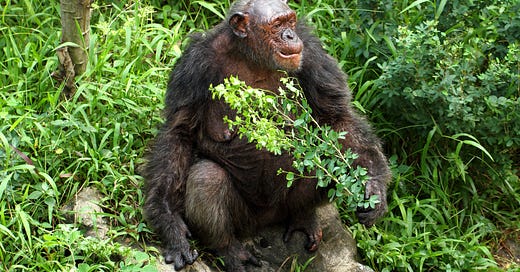Animal Self-Medication with Plants
Did you know that humans are not alone in self-medicating with natural remedies? I delve into intriguing instances of insects and primates using medicinal plants to heal and prevent diseases.
Today, chemicals derived from plants or developed based on the structures of plant compounds serve as vital drugs in various fields, including pain management, oncology, cardiology, gastroenterology, dermatology, and many more. To understand the current role of plants in medicine, it is imperative to first grasp their longstanding and essential significance throughout human history.
Wherever humanity has existed, a tradition of medicine has also thrived, and medicinal plants have played a key role from the earliest and most rudimentary practices to the most advanced modern procedures. But, how did it all begin? In today’s post, I describe how animals use plants as medicine. Observations of animal behavior may have served as a source of inspiration for early humans that sought out remedies from nature.
Animals that Self-Medicate with Plants
Humans are not the only creatures that have adopted the medicinal use of plants. You might be quite surprised to learn that many animals—even butterflies—self-medicate with medicinal plants! For example, if you have seen a dog eat grass, you have witnessed plant-based self-medication to treat an upset stomach or parasites. Importantly, this behavior is distinct from the normal consumption of materials to fulfill dietary requirements.
This self-medication behavior is known as zoopharmacognosy, a term derived from the root words zoon (animal), pharmakon (drug) and gnosis (knowing).
Animals use two types of self-medication behaviors:
Preventive: using medicine in the absence of disease symptoms; and
Therapeutic: using medicine to treat existing disease.
Many examples of self-medication behavior have been observed, though researchers are still in the early stages of understanding the scientific basis for these practices. Some of the most exciting recent studies on this topic involve investigations of insect behavior in the face of disease, which have revealed complex dynamics in disease ecology and host-parasite biology. For example, parasite-infected monarch butterflies protect their offspring by laying their eggs on certain species of milkweed (Asclepias spp., Apocynaceae), a practice that protects the eggs from high levels of parasite growth.

Animal self-medication is much more widespread than previously thought, with practices being documented among animals as diverse as insects and primates. Here are some examples:
Insects
Fruit flies engage in selective egg-laying behavior, in which they preferentially lay their eggs in high-ethanol food when parasitoid wasps are detected.
Monarch butterflies engage in selective egg-laying behavior, in which monarchs with heavy parasite loads lay their eggs on milkweeds (Asclepias spp., Apocynaceae) the produce high levels of cardenolides.
Wood ants engage in selective plant resin accumulation behavior, in which the antimicrobial resins of conifer trees are incorporated into the nest.
Woolly bear caterpillars engage in selective ingestion of plant toxins, in which parasitized caterpillars ingest large amounts of anti-parasitic pyrrolizidine alkaloids, resulting in increased survival.
Primates
Chimpanzees, bonobos, and lowland gorillas engage in selective leaf swallowing behavior, in which whole leaves are swallowed (e.g. Aspilia spp., Asteraceae). This has been linked to removal of intestinal parasites, such as nematodes and tapeworm.
Chimpanzees engage in bitter pith chewing behavior, in which the pith of young shoots of Vernonia amygdalina Delile, Asteraceae is chewed to release a bitter juice that is ingested. This juice is rich in sesquiterpene lactones (vernodaline and vernonioside B1) that have exhibited anthelmintic, anti-amoebic, anti-tumor and antibiotic properties.
The Takeaway
Nature speaks the language of chemistry and animals have been long attuned to the chemical signals emitted by plants. Plants produce these molecules as a means of defense or to attract pollinators and seed dispersers. Sometimes these molecules happen to also be a medicine or poison, depending on who consumes it. There is much we have to learn from nature, and the most important piece of advice I offer to anyone interested in science is to learn to be a good observer.
My challenge for readers this week: observe animal behavior in your neighborhood. Whether it is a pet or a wild creature, spend some time in quiet observation. You may be surprised at what you learn from watching animals engage with nature. Share your findings in this thread or the comments below!
Yours in health, Dr. Quave
Cassandra L. Quave, Ph.D. is a scientist, author, speaker, podcast host, wife, mother, explorer, and professor at Emory University School of Medicine. She teaches college courses and leads a group of research scientists studying medicinal plants to find new life-saving drugs from nature. She hosts the Foodie Pharmacology podcast and writes the Nature’s Pharmacy newsletter to share the science behind natural medicines. To support her effort, consider a paid or founding subscription, with founding members receiving an autographed 1st edition hardcover copy of her book, The Plant Hunter.





